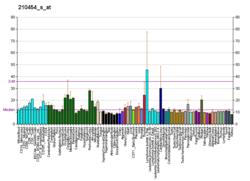| KCNJ6 |
|---|
|
| Available structures |
|---|
| PDB | Ortholog search: PDBe RCSB |
|---|
| List of PDB id codes |
|---|
2E4F, 3AGW, 3AT8, 3AT9, 3ATA, 3ATB, 3ATD, 3ATE, 3ATF, 3AUW, 3SYA, 3SYC, 3SYO, 3SYP, 3SYQ, 3VSQ, 4KFM |
|
|
| Identifiers |
|---|
| Aliases | KCNJ6 , BIR1, GIRK-2, GIRK2, KATP-2, KATP2, KCNJ7, KIR3.2, hiGIRK2, KPLBS, potassium voltage-gated channel subfamily J member 6, potassium inwardly rectifying channel subfamily J member 6 |
|---|
| External IDs | OMIM: 600877; MGI: 104781; HomoloGene: 1688; GeneCards: KCNJ6; OMA:KCNJ6 - orthologs |
|---|
|
|
| RNA expression pattern |
|---|
| Bgee | | Human | Mouse (ortholog) |
|---|
| Top expressed in | - pars reticulata
- pars compacta
- middle temporal gyrus
- Brodmann area 23
- frontal pole
- postcentral gyrus
- Brodmann area 46
- orbitofrontal cortex
- entorhinal cortex
- cerebellar vermis
|
| | Top expressed in | - dentate gyrus of hippocampal formation granule cell
- lumbar subsegment of spinal cord
- primary visual cortex
- superior frontal gyrus
- pretectal area
- gastrula
- blastocyst
- CA3 field
- lumbar spinal ganglion
- supraoptic nucleus
|
| | More reference expression data |
|
|---|
| BioGPS | |
|---|
|
|
|
| Wikidata |
|




